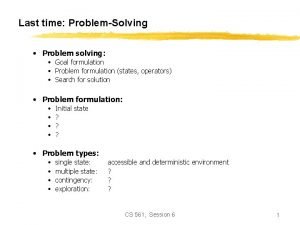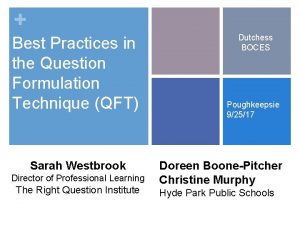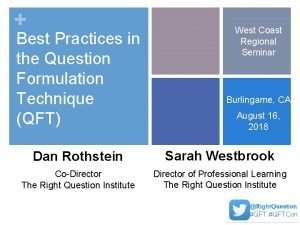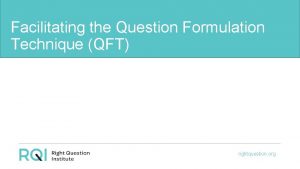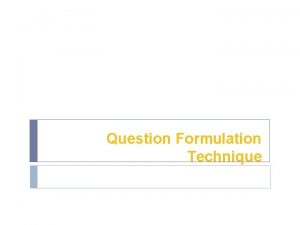Facilitating The Question Formulation Technique QFT www rightquestion
















- Slides: 16

Facilitating The Question Formulation Technique (QFT) www. rightquestion. org

Why use the QFT? - Give students independence and more responsibility - See what students are already thinking about the subject - Allow to the students to connect with the subject on a deeper level - Give students the opportunity to learn the valuable skill of asking questions - Give students a chance to work with peers www. rightquestion. org

Steps of QFT Step 1: Rules for Producing Questions Step 2: Introduce the Question Focus Step 3: Produce Questions Step 4: Improve Questions Step 5: Prioritize Questions Step 6: Share Your Questions Step 7: Discuss Next Steps Step 8: Reflect www. rightquestion. org

Step 1: Rules for Producing Questions § Ask as many questions as you can § Do not stop to discuss, judge or answer the questions § Write down every question exactly as it is stated § Change any statement into a question What might be difficult about following these rules? www. rightquestion. org

Step 2 & 3: Producing the Questions Question Focus: Concrete Wood 1. Follow the Rules for Producing Questions. 2. Number your questions. www. rightquestion. org

Step 4: Improve Your Questions You might have these two kinds of questions in your list: • Closed-ended questions – they can be answered with “yes” or “no” or with one word. • Open-ended questions – they require an explanation and cannot be answered with yes” or “no” or with one word. www. rightquestion. org

Step 4: Improve Your Questions Identify closed- and open-ended questions. 1. Mark the closed-ended questions with a C and the openended questions with an O. www. rightquestion. org

Step 4: Improve Your Questions 2. Name advantages of asking closed-ended questions. www. rightquestion. org

Step 4: Improve Your Questions 3. Name disadvantages of asking closed-ended questions. www. rightquestion. org

Step 4: Improve Your Questions 4. Name advantages of asking open-ended questions. www. rightquestion. org

Step 4: Improve Your Questions 5. Name disadvantages of asking open-ended questions. www. rightquestion. org

Step 4: Improve Your Questions 6. Review your list of questions and change one closed-ended question into an open-ended. Then, change one open-ended question into a closed-ended one. www. rightquestion. org

Step 5: Prioritize Your Questions • Choose three most important questions from your list. • Keep in mind the Question Focus. • Mark each priority question with an “X” • DO NOT PICK QUESTIONS YOU ALREADY CAN ANSWER! www. rightquestion. org

Step 6: Share Your Questions Please share: • The questions you changed from closed to open-ended and from open-ended to closed. Read each question as originally written and how it was changed • Your three priority questions • Your rationale for selecting those three • The numbers of your priority questions www. rightquestion. org

Step 7: Next Steps How are you going to use your three priority questions? Choose one that you want to investigate further. www. rightquestion. org

Step 8: Reflection 1. What did you learn? 2. What value does it have? 3. How can you use this in your classroom? www. rightquestion. org
 Qft technique
Qft technique Qft technique
Qft technique Question formulation technique pdf
Question formulation technique pdf Qft questioning
Qft questioning Question formulation technique worksheet
Question formulation technique worksheet Question formulation technique examples
Question formulation technique examples Qft examples
Qft examples Qfocus examples
Qfocus examples Question formulation technique worksheet
Question formulation technique worksheet Why problem formulation follow goal formulation
Why problem formulation follow goal formulation Qft protocol
Qft protocol What is qft
What is qft Qft questioning
Qft questioning Qft
Qft Level 1 2 3 costa level of questioning
Level 1 2 3 costa level of questioning Facilitating learning child and adolescent development
Facilitating learning child and adolescent development Marketing channel concept
Marketing channel concept









